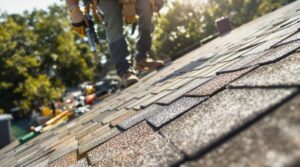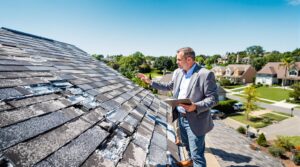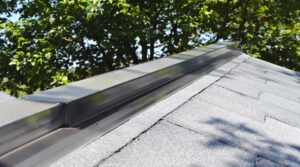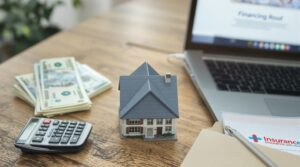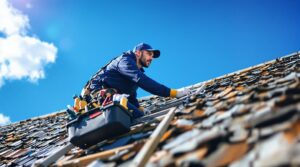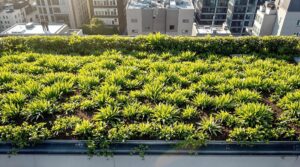Ever wondered how long that trusty built-up roofing (BUR) system above your head will last? Let’s dive into the lifespan of these layered warriors!
Think of BUR as a protective cake – the more layers you add, the longer it shields your building. A well-installed BUR system typically stands strong for 15-30 years, but here’s the sweet spot: with proper TLC, you can stretch that to an impressive 40 years.
Want to boost your roof’s staying power? Each additional layer you add gifts you roughly five more years of protection. But don’t just stack layers and forget about it! Like any reliable guardian, your BUR needs regular check-ups to perform at its best.
The secret sauce to a long-lasting BUR system lies in three key ingredients:
- Professional installation (no cutting corners!)
- Top-notch materials (quality over quick fixes)
- Environmental harmony (how well it handles your local weather)
Pro tip: Schedule those roof inspections twice a year and tackle repairs faster than a leak can spread. Think of it as giving your roof a health check-up – catch those small issues before they become roofing emergencies. After all, your BUR system isn’t just another layer on your building; it’s your first line of defense against Mother Nature’s mood swings!
Key Takeaways
Wondering how long your built-up roofing will shelter your building? Let’s dive into the lifespan of these multi-layered workhorses.
Think of BUR as a layer cake of protection – each additional layer you add strengthens your roof’s defense against Mother Nature. A well-installed built-up roof typically guards your building for 15-30 years, with most systems hitting their stride around the 20-year mark.
Want to maximize your roof’s longevity? Here’s the secret sauce: every extra layer of BUR material you incorporate adds roughly five years to your roof’s life expectancy. It’s like adding insurance policies on top of each other!
Your roof’s durability isn’t just about the materials – it’s a story of survival against the elements. Just as a car performs differently in various climates, your BUR system’s lifespan depends on local weather patterns, sun exposure, and temperature swings. With proper TLC and professional installation, these robust systems can soldier on for up to 40 years in ideal conditions.
In the commercial roofing arena, BUR stands tall among its competitors. When you stack it up against TPO, PVC, or modified bitumen systems, you’ll find it matches or often outlasts them – proving that sometimes, the classic approaches still pack the biggest punch.
Understanding the Average Lifespan of Built-Up Roofing
Built-up roofing (BUR) systems typically last between 15 to 30 years, with an average lifespan of 20 years when properly maintained.
Contrary to common roofing myths, the durability of BUR systems greatly depends on the number of layers installed, with each additional layer potentially extending the lifespan by approximately five years.
One of the prevalent lifespan misconceptions is that all BUR systems perform identically regardless of installation quality.
However, professional installation, material quality, and environmental conditions play vital roles in determining longevity.
When compared to other roofing materials, BUR systems offer competitive durability, falling within similar ranges as asphalt shingles (20-30 years) but generally lasting longer than modified bitumen systems.
Regular maintenance, including prompt repairs and routine inspections, remains essential for achieving maximum service life.
Key Factors That Impact BUR Longevity
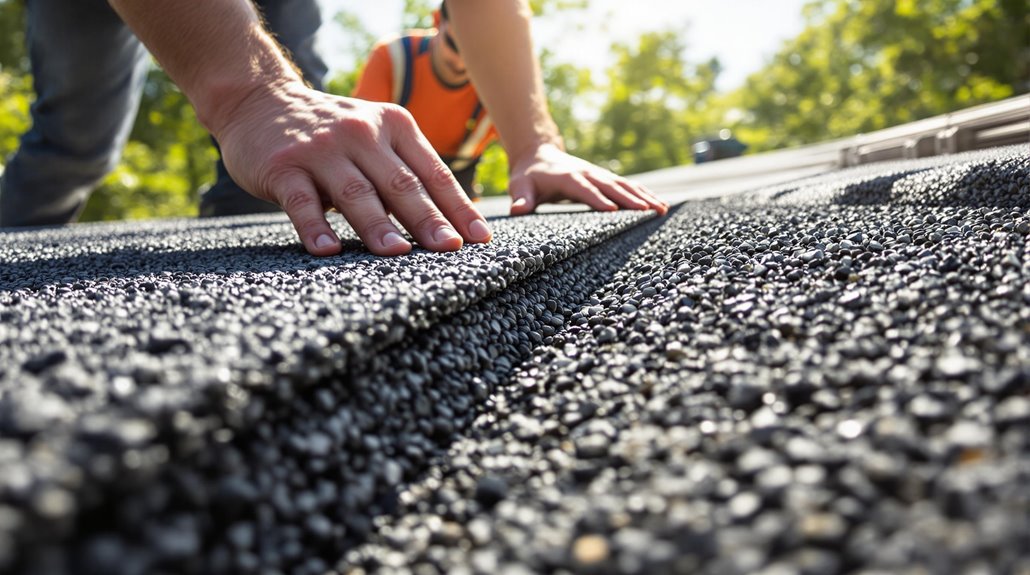
While numerous variables influence the durability of built-up roofing systems, four important factors stand out: material quality, installation expertise, environmental conditions, and maintenance practices.
- Material selection greatly affects longevity, with high-quality asphalt layers, durable gravel, and compatible components from reputable manufacturers ensuring ideal performance.
- Installation techniques and contractor expertise play vital roles, as proper application methods, adherence to manufacturer guidelines, and effective sealing around penetrations prevent premature failures.
- Environmental factors, including UV exposure, temperature fluctuations, and regional weather patterns, impact the roof’s durability and require consideration during system design.
- Regular inspections, timely repairs, and thorough maintenance plans are essential for maximizing the lifespan of BUR systems, particularly in challenging climates where environmental stressors are more severe.
Signs Your BUR System Needs Replacement
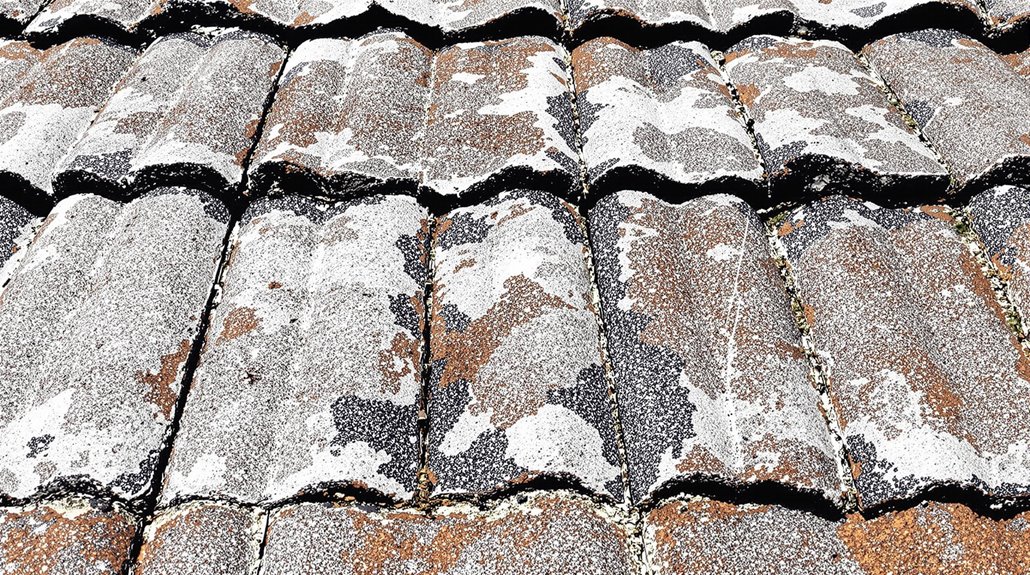
Recognizing the signs of BUR system deterioration enables property owners to address replacement needs before catastrophic failure occurs.
Physical damage indicators include seam defects, punctures, blisters, and surface thinning. Professional inspection techniques often reveal water infiltration through interior leaks, ceiling stains, and the presence of mold or mildew.
Advanced deterioration of roofing materials manifests through surface erosion, granule loss, and UV degradation.
When a BUR system approaches or exceeds its 20-25 year lifespan, systematic failures become more prevalent. Additional warning signs include decreased energy efficiency, widespread surface deterioration, and the presence of algae or moss growth.
Multiple indicators occurring simultaneously, combined with professional assessment findings, typically signal the need for complete system replacement rather than continued repairs.
Maximizing Your BUR Roof’s Service Life
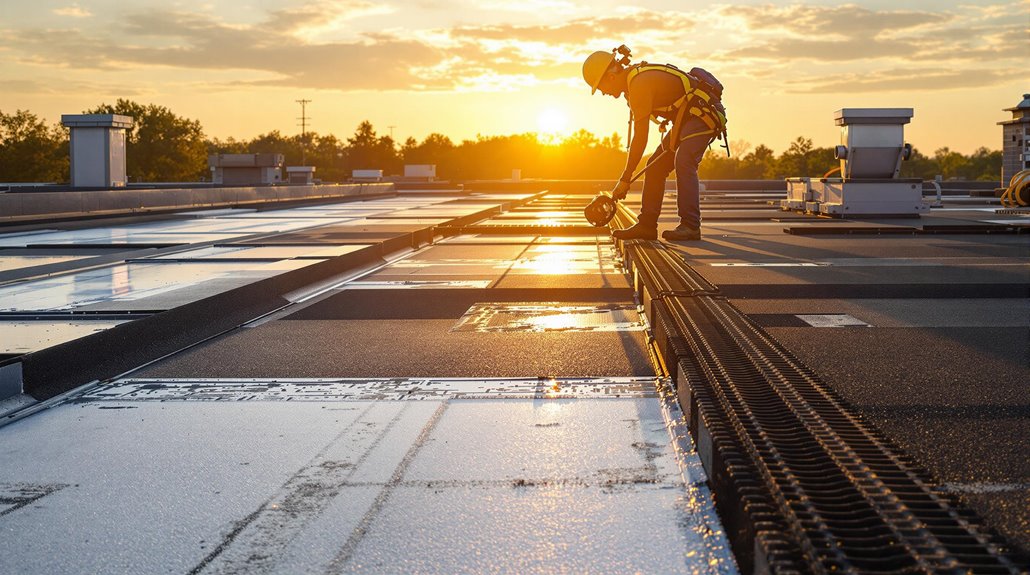
A thorough maintenance schedule represents the cornerstone of maximizing a built-up roof’s service life, with bi-annual inspections and prompt repairs serving as critical elements.
Installation quality greatly impacts longevity, making it essential to avoid common pitfalls such as improper layering and inadequate drainage solutions.
The selection of premium-grade materials, including high-quality felts and bitumen, provides the foundation for extended service life and peak performance throughout the system’s lifecycle.
Regular Maintenance Schedule Essential
To maximize the service life of a built-up roofing (BUR) system, implementing a thorough maintenance schedule is essential. Preventive measures and maintenance techniques greatly extend roof longevity while protecting building assets and occupants. Regular inspections and timely repairs prevent minor issues from escalating into major problems, ultimately reducing long-term costs.
- Annual detailed inspections are mandatory, with older roofs requiring biannual evaluations.
- Seasonal maintenance includes cleaning gutters, downspouts, and valleys twice yearly.
- Post-severe weather inspections help identify and address storm-related damage promptly.
- Regular trimming of overhanging branches and proper sealing around roof penetrations prevent water intrusion.
These systematic maintenance procedures guarantee peak performance, enhance safety, and protect the substantial investment in the roofing system while maximizing its service life.
Avoid Common Installation Mistakes
While regular maintenance extends BUR roof life, proper installation forms the foundation for long-term performance. Several critical installation techniques must be followed to maximize durability.
Proper alignment of materials, secure fastening, and correct overlapping prevent water infiltration and displacement. Installing adequate ventilation systems, including ridge and soffit vents, is vital to control moisture and heat buildup.
Common installation errors to avoid include improper flashing around chimneys and vents, inadequate seam sealing, and reusing old materials. New, compatible materials that meet industry standards should always be used.
Closed-cut valleys require proper sealing with roof cement, and step flashing must be correctly installed to prevent leaks. Additionally, proper panel alignment ensures correct water direction and seam overlap.
Thorough damage documentation through photos and detailed inspection records helps protect your investment if insurance claims become necessary later.
Choose Quality Materials Always
Selecting premium-grade materials stands as the cornerstone of maximizing a built-up roof’s service life. Material durability directly influences long-term performance and protection against environmental stressors. Quality components guarantee superior resistance to weathering, UV exposure, and temperature fluctuations while maintaining structural integrity.
- High-grade bitumen and reinforced felts create a robust waterproof barrier.
- Premium insulation options, including rigid boards or lightweight concrete, enhance thermal efficiency.
- Fiberglass mats or organic felt reinforcement layers strengthen overall system stability.
- UV-resistant surfacing materials protect underlying components from degradation.
The selection of superior materials across all roofing layers considerably reduces maintenance requirements and extends service life.
Quality components work synergistically to prevent water infiltration, resist building movement, and maintain consistent performance throughout the roof’s lifespan, ultimately proving more cost-effective than lower-grade alternatives.
Professional installation with specialized safety equipment is essential for ensuring proper material placement and maximizing system longevity.
Common Problems That Reduce BUR Lifespan

Among the most significant issues affecting built-up roofing systems, alligatoring and surface cracks represent critical threats to membrane integrity.
These surface deterioration patterns typically manifest as interconnected cracks resembling alligator skin, indicating asphalt shrinkage and material fatigue.
Drainage system failures compound these problems by allowing water to pool and accelerate the breakdown of the roofing membrane, particularly in areas where surface cracks have already developed.
Alligatoring and Surface Cracks
Two significant threats to built-up roofing systems are alligatoring and surface cracks, both of which can substantially reduce the roof’s expected lifespan.
These issues typically arise from prolonged exposure to environmental stresses, poor installation practices, and inadequate maintenance. Understanding their characteristics and implementing proper prevention strategies is vital for maintaining roof integrity.
Key considerations for managing these issues include:
- Regular professional inspections to identify early signs of surface cracks and deterioration
- Implementation of proper alligatoring prevention methods, including reflective coatings and high-quality materials
- Prompt repair of minor cracks before they develop into major structural problems
- Installation of proper drainage systems to prevent water accumulation and subsequent damage
Professional assessment and timely intervention are essential when these issues are detected, as both conditions can lead to water infiltration and compromised roof performance.
Drainage System Failures
Drainage system failures represent a critical factor in reducing the lifespan of built-up roofing systems. Poor drain system design, including inadequate primary and secondary drainage, often leads to water intrusion and potential roof collapse.
The absence of proper strainers and undersized scuppers greatly impairs drainage functionality, while improper modifications to existing systems further compromise roof safety.
Inadequate maintenance practices frequently result in debris accumulation, clogged drains, and water ponding. Multiple re-roofing layers can obstruct original drain systems, and improper repairs, such as patching over overflow scuppers, eliminate critical secondary drainage paths.
Building code compliance for secondary drain systems is essential, requiring regular inspections and professional maintenance to prevent premature roof failure. Certified contractors should perform all drainage system modifications to guarantee proper functionality.
Climate Considerations for BUR Durability
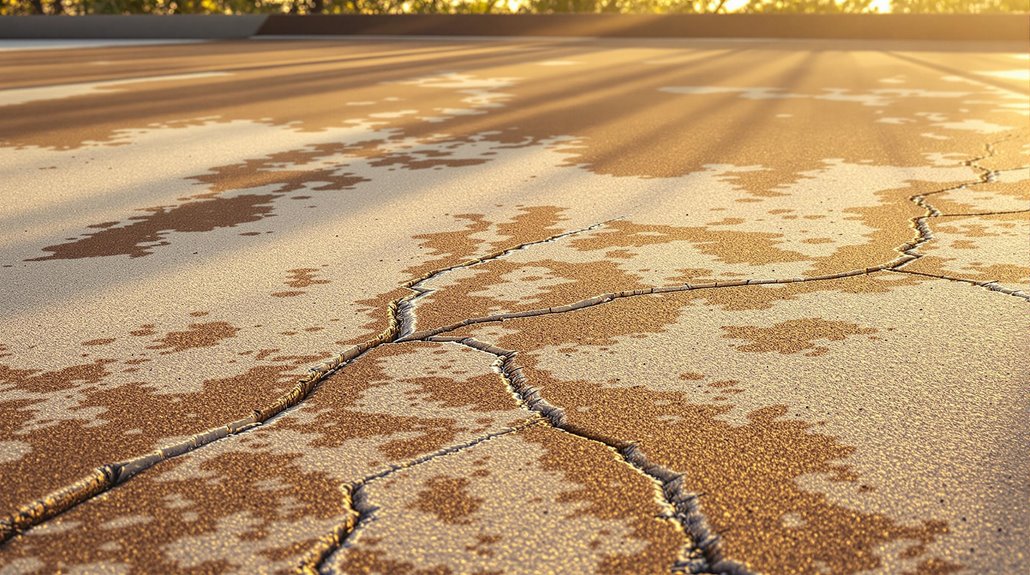
Weather conditions play a critical role in determining the durability and longevity of built-up roofing (BUR) systems. Climate variability impacts every aspect of BUR performance, from material integrity to structural stability. UV radiation effects accelerate the degradation of roofing components, leading to brittleness and potential system failure.
Key climate factors affecting BUR systems include:
- Extreme temperature fluctuations cause materials to expand and contract, creating stress fractures and weakened seams.
- Heavy rainfall penetrates existing cracks, resulting in water damage and potential mold growth.
- High winds can compromise roof integrity through lifting and tearing of materials.
- Intense sun exposure in regions like Tennessee accelerates material breakdown.
Regular maintenance and preventive measures, such as reflective coatings and proper drainage systems, help mitigate these climate-related challenges and extend BUR lifespan.
Maintenance Tips to Extend BUR Life
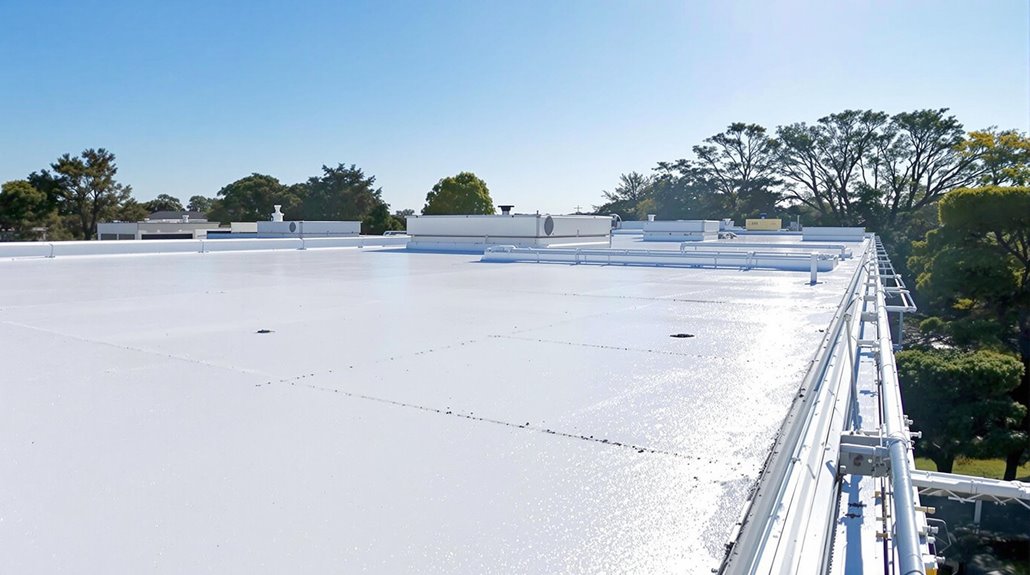
Maintaining the integrity of built-up roofing systems requires a thorough approach that combines regular inspections, preventative measures, and timely repairs. A structured maintenance frequency should include regular cleaning of gutters, drains, and debris removal from the roof surface.
Professional roof inspection activities must focus on identifying signs of blistering, cracking, and examining the condition of flashings and equipment connections.
Essential maintenance practices include tree management to prevent branch damage, proper sealing of roof penetrations, and the application of reflective coatings to minimize UV degradation.
When repairs are necessary, contractors should employ the three-course repair method or appropriate alternative techniques for specific conditions.
Implementing these maintenance strategies, coupled with detailed documentation of all roofing activities, greatly extends the BUR system’s service life.
Cost vs. Longevity: BUR Investment Analysis
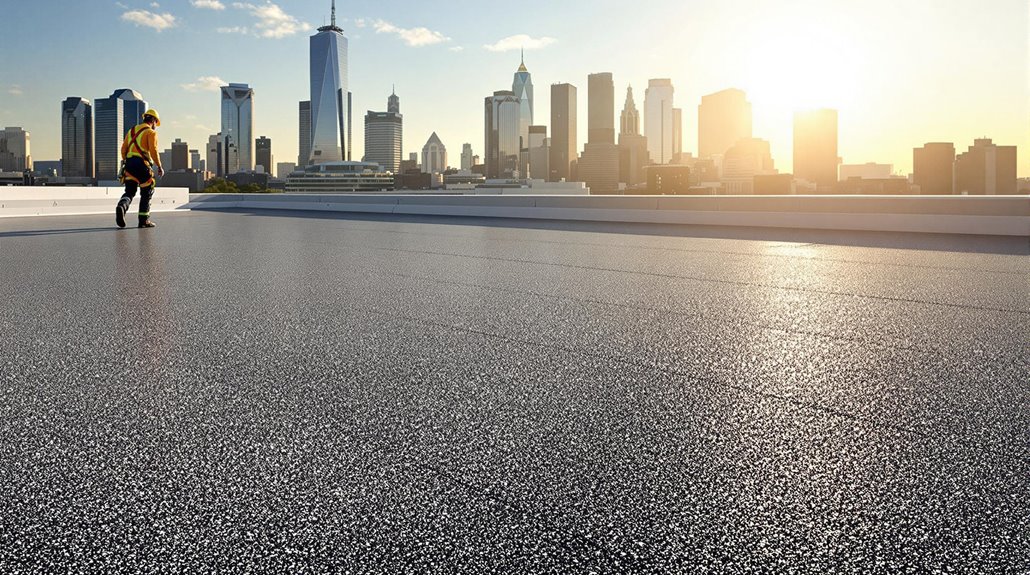
The initial investment of $3.50 to $7 per square foot for Built-Up Roofing yields a significant return through its 15-30 year lifespan.
Annual maintenance costs remain relatively low compared to other roofing systems, typically requiring only routine inspections and minor repairs to maintain peak performance.
When analyzing the total cost of ownership, BUR’s durability, energy efficiency, and extended service life often justify the higher upfront expenditure through reduced long-term operational expenses.
Initial Investment Comparisons
Built-up roofing systems represent a considerable investment decision that warrants careful analysis of both initial costs and long-term value.
When conducting an initial cost analysis, property owners must consider the $3.50 to $7 per square foot range, which positions BUR competitively against alternatives like EPDM and PVC roofing systems.
- BUR systems demonstrate comparable costs to EPDM ($3 to $7 per square foot) while offering superior durability.
- PVC roofing costs notably more ($7 to $12 per square foot) with a similar 20-year lifespan.
- Labor costs constitute a substantial portion of the initial investment.
- Quality material selection impacts long-term savings through extended durability.
The multiple-layer construction and minimal maintenance requirements of BUR systems often justify the initial investment through reduced lifecycle costs and enhanced building protection.
Annual Maintenance Costs
Strategic annual maintenance represents a critical factor in maximizing built-up roofing investments, with costs typically ranging from 2% to 8% of initial installation expenses.
Cost analysis demonstrates that proactive roof maintenance averages 14¢ per square foot, compared to 25¢ for reactive maintenance over a 15-year period.
The financial implications of maintenance strategies are significant. Building owners implementing regular maintenance programs can achieve up to 50% savings over a 30-year roof lifecycle versus replacing it every 15-20 years.
This preventive approach extends roof longevity by 7-10 years compared to reactive maintenance scenarios. With average lifecycle costs exceeding $127,500, systematic maintenance proves economically advantageous, requiring only 1-3% of total lifecycle costs annually while substantially reducing the likelihood of premature replacement expenses.
Long-Term Value Assessment
When evaluating built-up roofing systems from a long-term investment perspective, extensive analysis reveals favorable cost-benefit ratios spanning 15-30 years. The initial investment of $4-$10 per square foot translates into substantial cost efficiency when factored across the roof’s extended lifespan. Regular maintenance and proper installation greatly enhance the return on investment.
- Material selection impacts both durability and environmental impact, with sustainable options offering enhanced long-term value.
- Multiple layers can extend lifespan by approximately 5 years per layer, improving overall investment returns.
- Annual energy savings contribute to decreased operational costs throughout the system’s lifecycle.
- Warehouse installations demonstrate scalable value, with costs ranging from $55,000 to $1,670,000+ based on size.
These factors collectively support BUR systems as a strategic long-term roofing investment.
Comparing BUR Lifespan to Alternative Roofing Systems
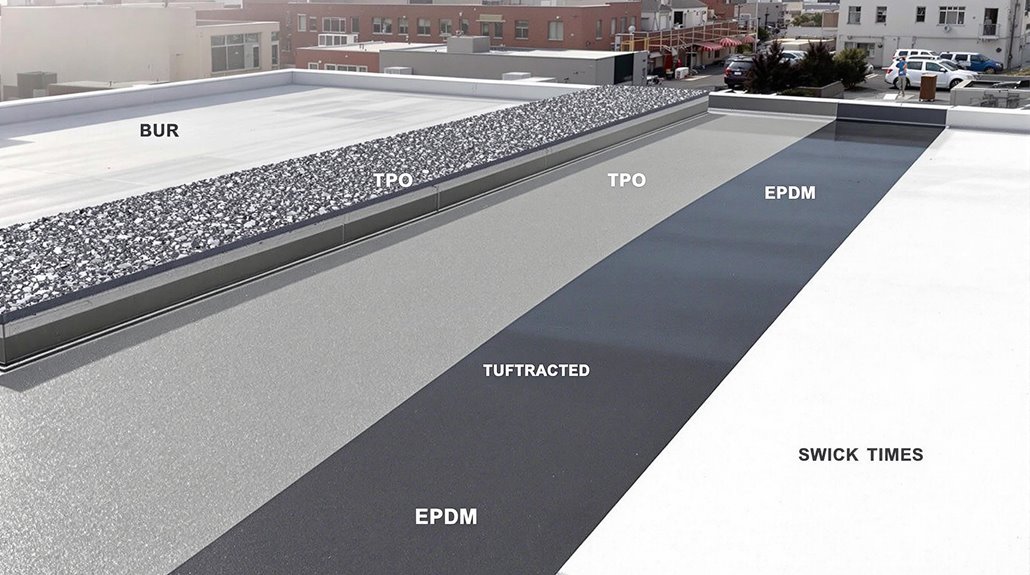
Understanding the relative lifespans of different roofing systems is essential for making informed decisions about commercial roof installations. Among BUR advantages, its 15-30 year lifespan with potential extension to 40 years through proper maintenance stands out.
Compared to modified bitumen‘s 10-20 years, BUR demonstrates superior longevity. However, BUR disadvantages include more complex installation requirements.
Single-ply systems like TPO and PVC offer 20-year lifespans with energy-efficient properties, while EPDM rubber roofing matches BUR’s durability at 20-30 years.
Each system presents distinct cost considerations, with BUR typically requiring higher initial investment but delivering extended service life. The multiple layers of BUR contribute to its durability, with each additional layer potentially adding five years to the system’s lifespan.
Professional Installation’s Role in BUR Longevity
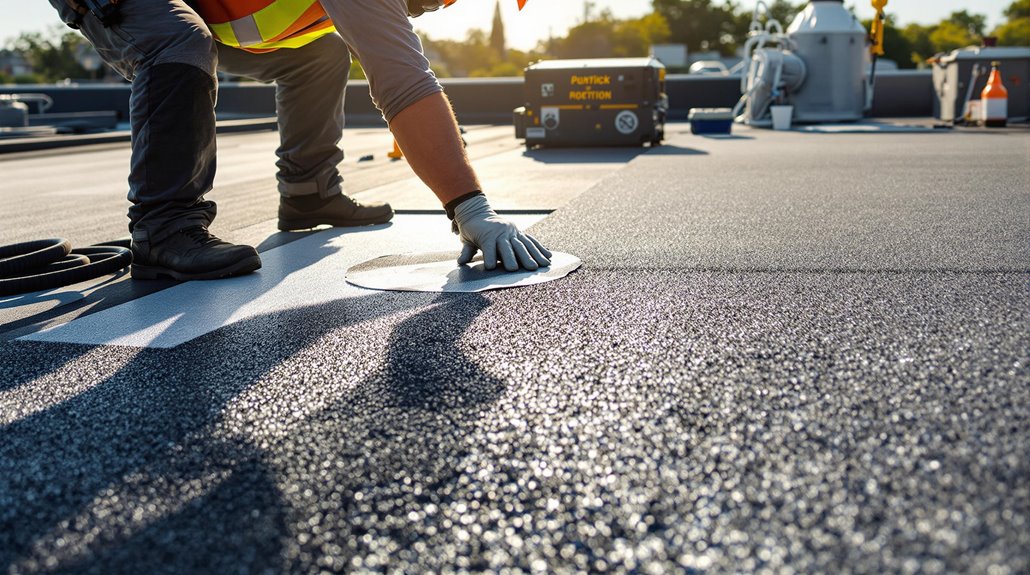
Professional installation serves as the cornerstone of built-up roofing longevity, determining both initial performance and long-term durability. Proper installation techniques directly impact the roof’s ability to withstand environmental stresses and maintain structural integrity over time. Contractor qualifications play a crucial role in guaranteeing accurate application of materials and adherence to manufacturer specifications.
- Precise layering and seam sealing prevent water infiltration and maintain membrane stability.
- Proper handling of materials and tools reduces installation defects and premature failures.
- Expert preparation of the roof surface guarantees ideal adhesion between layers.
- Thorough quality control during installation identifies and corrects potential issues.
Regular maintenance following professional installation further extends the BUR system’s lifespan by addressing minor issues before they develop into significant problems.
The Benefits Of Consulting A Public Adjuster
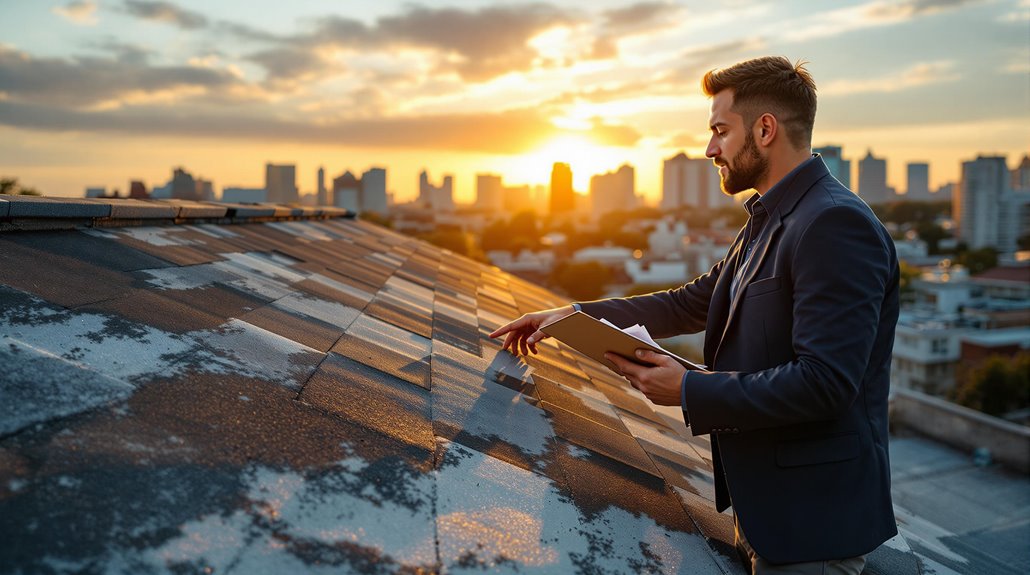
When evaluating built-up roofing damage, public adjusters provide essential expertise in traversing complex insurance claims through their thorough understanding of policy coverage and documentation requirements.
Their objective damage evaluations and specialized knowledge help identify both obvious and hidden roofing issues that might otherwise go unclaimed.
Public adjusters’ professional negotiation skills and systematic approach to claims processing typically result in higher settlements while reducing the time and stress associated with insurance procedures.
Studies demonstrate that policyholders receive 800% higher settlements when working with qualified public adjusters on their insurance claims.
Expertise In Insurance Claims
A public adjuster’s expertise in insurance claims provides invaluable advantages for policyholders facing complex roofing damage settlements. Their extensive understanding of insurance policies, regulations, and claims advocacy guarantees maximum benefit for property owners dealing with built-up roofing damage.
Key advantages of their expertise include:
- Thorough interpretation of policy language and coverage limitations specific to roofing systems
- Strategic documentation and presentation of damage evidence to support claims
- Skilled negotiation with insurance carriers to secure fair compensation
- Expert navigation of regulatory requirements and compliance issues
Their specialized knowledge allows for effective management of the claims process while reducing stress for property owners.
Public adjusters handle all aspects of the claim, from initial documentation to final settlement, enabling policyholders to focus on property restoration and recovery.
Statistics show that working with a public adjuster can result in 574% higher settlements compared to handling claims independently.
Objective Damage Assessment
Objective damage assessment through public adjusters represents a foundational element of successful insurance claims for built-up roofing systems.
These state-licensed professionals conduct thorough evaluations to guarantee extensive damage documentation, identifying both visible issues and potential future complications that could affect the roofing structure.
Public adjusters leverage their expertise to interpret insurance policies, prepare detailed claim documentation, and engage in insurance negotiations on behalf of policyholders.
Their systematic approach maximizes claim outcomes by addressing all aspects of roof damage while preventing oversight of essential details.
This professional assistance greatly enhances the accuracy of damage estimates and strengthens the policyholder’s position during settlement discussions.
The independent evaluation also provides vital evidence for reopening claims when necessary, securing fair compensation for all documented roofing issues.
With settlement rates 800% higher through public adjuster involvement, property owners gain significant advantages in securing proper compensation for roofing damage.
Streamlined Claim Process
Consulting a public adjuster greatly streamlines the built-up roofing insurance claim process through systematic documentation, efficient claim management, and expert negotiation capabilities.
Their professional expertise markedly enhances claim efficiency while ensuring documentation accuracy throughout the entire process.
Key elements of a streamlined claim process include:
- Thorough damage assessment and detailed documentation using advanced technology and standardized workflows
- Centralized record-keeping systems that maintain vital evidence and policy information
- Automated task management for repetitive processes, reducing administrative delays
- Expert negotiation with insurance companies, resulting in settlements averaging 30% higher than self-managed claims
This systematic approach allows property owners to focus on recovery while the public adjuster handles all aspects of the claim, from initial filing through final settlement.
Studies show that public adjuster settlements can be up to 800% higher compared to independently filed insurance claims.
Higher Claim Payouts & Settlements
Public adjusters demonstrably increase claim payouts and settlements for built-up roofing insurance claims through their specialized expertise and strategic negotiation skills.
Their thorough understanding of insurance policy terms and procedures enables them to identify all compensable damages and maximize benefits for policyholders.
Through effective claim negotiation strategies, public adjusters secure higher settlements by leveraging their knowledge of policy provisions and market values.
Statistics confirm that professionally managed claims typically result in larger payouts compared to those handled directly by policyholders.
Operating on a percentage-based fee structure, typically ranging from 5% to 20% of the settlement, public adjusters are inherently motivated to obtain maximum compensation.
This arrangement, often regulated by state laws, guarantees alignment between the adjuster’s interests and the policyholder’s financial recovery objectives.
The pre-vetted licensed adjusters in the Public Claims Adjusters Network must maintain a perfect record with no Department of Insurance complaints for the previous 12 months.
About The Public Claims Adjusters Network (PCAN)
Professional claims management networks like the Public Claims Adjusters Network (PCAN) provide extensive support services for property owners seeking fair insurance settlements. Public adjusters work on a contingency basis, offering expert guidance throughout the claims process without requiring upfront fees.
These networks deliver value through:
- Detailed claim assessments utilizing industry-leading estimating software
- Strategic negotiations with insurance companies to maximize settlement amounts
- Efficient communication channels for status updates and immediate support
- Expert documentation and evidence gathering to strengthen claim positions
Public adjusters bring extensive experience in managing complex claims, often securing settlements 300-400% higher than unassisted claims.
Their professional expertise helps guarantee thorough damage identification, proper claim filing procedures, and superior settlement outcomes for property owners.
State emergency claims are subject to a maximum fee of 10% during the first year of recovery efforts.
Frequently Asked Questions
Can a BUR Roof Be Partially Replaced, or Must It Be Replaced Entirely?
BUR roofs can undergo partial replacement for isolated damage, though full replacement is often recommended due to potential hidden issues and the interconnected nature of the multi-layer roofing system.
Is BUR Roofing Environmentally Friendly and Recyclable at the End of Life?
Like a double-edged sword, BUR roofing presents environmental challenges during manufacturing but offers sustainability practices through end-of-life recycling options, where materials can be repurposed for pavement and construction applications.
How Soon After Installation Can Foot Traffic Resume on a BUR Roof?
Initial foot traffic can resume 24-48 hours after final layer installation, though complete material stability requires several days. Environmental conditions and adhesive curing times influence the exact timing.
Does the Color of the Top Aggregate Layer Affect the Roof’s Performance?
Aggregate color greatly impacts roof performance through thermal properties. Light-colored aggregates reflect heat and reduce thermal stress, while darker aggregates absorb more heat, affecting energy efficiency and long-term durability.
Can Solar Panels Be Safely Installed on a Built-Up Roofing System?
Solar panel installation can be safely executed on built-up roofing systems when proper structural assessments are performed, roofing safety protocols are followed, and appropriate mounting techniques are implemented.
References
- https://shumakerroofing.com/built-up-roofing-benefits-costs-and-lifespan-explained/
- https://steadfastroofingfl.com/blog/exploring-the-durability-of-built-up-roofing-systems/
- https://www.waterproofmag.com/2024/12/built-up-roofing-101-qa/
- https://temaroofingservices.com/how-long-does-a-built-up-roof-last-a-guide-to-roofing-materials/
- https://www.billraganroofing.com/blog/factors-impact-how-long-roof-last
- https://northstarext.com/blogs/built-up-roof-life-expectancy/
- https://heritage-exteriors.com/how-long-does-a-roof-last-a-guide/
- https://www.improveitmd.com/blog/how-long-does-a-roof-last-everything-you-need-to-know
- https://premiersystemsroofing.com/blog/7-factors-that-affect-how-long-your-roof-lasts/
- https://centralroof.com/8-built-up-roofing-must-know-pros-cons/
